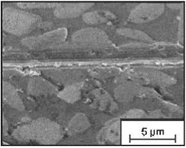The machinability of brittle materials significantly variable in contrast to metallic materials due to the characteristics described above.
When machining brittle materials, as opposed to machining ductile materials, we proceed from the assumption that, with increasing penetration depths, material separation becomes dominated by the characteristic behaviour of brittle materials, i. e. microcrack formation and resultant fragment breakaway.
Fundamentally it can be stated that, in case of a local loading of brittle materials (observing the microscopically small chip formation zone) the same action mechanisms are always prevalent — crack initiation and propagation and plastic material deformation.
As the grain cutting edge penetrates into the brittle material, radial and lateral cracks form in the tool material. This is illustrated in Fig. 4-17, left. Actual chip removal in this case takes place by means of lateral cracks, which cause spalling of the material. Axial cracks lead on the other hand to permanent damage to the tool’s external area. Such sub-surface damage, non-detectable with commonly used quality testing methods, can lead to premature failure of the components.
A ductile chip removal can, however, also be realised in the case of brittle materials (Fig. 4-17, right). To achieve this, reduced chip thicknesses are necessary, not exceeding a critical value hcu, crit according to the following formula
 The critical chip thickness is determined accordingly by the material characteristic values of fracture toughness Kc,
The critical chip thickness is determined accordingly by the material characteristic values of fracture toughness Kc,
BIFA91].
![]()
 |
 |
